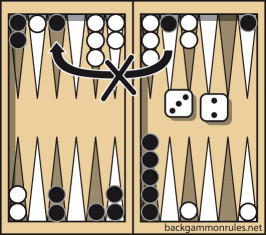Moves
A point can only have checkers of one color at a time:
Possible moves are to points that are 
Not allowed are moves involving a point the opponent made (4) by having two or more of his checkers on it (thereby creating an obstacle).
- Opposing checkers cannot land on it. 
2. A double 3 is rolled: To use all the moves on one checker, all intermediate points (the third, sixth and ninth) and the landing point (twelfth) must be free from obstacles. If the double occured in the figure above, the single black checker could not move at all due to the first and only obstacle on the third point. End a turnTo end your turn pick up your dice. The movement rules for bearing off are described in the => End game section. Next -> Start and middle game |
Menu |
|
All content is © Emil Svensson Network sites: Backgammon in Swedish, Backgammon spielregeln, Free poker |


